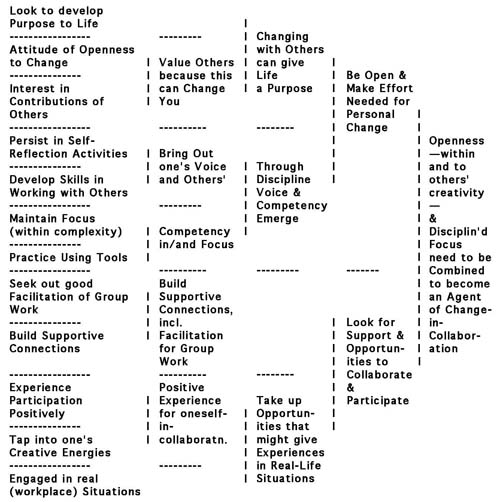Strategic Personal Planning
In order to complete a satisfying project you need to focus on something tight and do-able. Strategic Personal Planning allows you to arrive at this focus by first opening out and acknowledging a wide range of factors and wishes that your work could take into account.Strategic Personal Planning is based on the strategic participatory planning workshop process developed by the Institute for Cultural Affairs (ICA; see think-piece in Part 4 on Action Research and Participation). The basic propositions of the ICA workshop process include the following:
To adapt these principles to Strategic Personal Planning means that you should hope to come out with a plan for your project that is richer, deeper, and has more dimensions than what you came in with. The more angles on yourself that are brought out by the process, the more likely you are to create something you did not anticipate. The experience of that creativity, in turn, leads you to be more likely to carry out the plan you arrive at.
The Strategic Personal Planning process begins with the “practical vision” stage. The idea is to generate a larger vision of your work that underlies the specific project you are undertaking. In that spirit, do not focus specifically on your project topic. Instead, consider a more global question: What is needed for your personal and professional development in [insert here: general area required to be addressed by the project]?
Steps
Post-it brainstorming
Undertake a Future Ideal Retrospective: Imagine yourself some time after the project is over looking back with a sense of accomplishment on how far you have come in the area of [insert general area required to be addressed by the project]. (Construe accomplishment broadly so it can include your own reflection and growth.) What happened to make this so?—What different kinds of things do you envisage having gone into or contributed to that personal and professional development? In preparing for this brainstorming, take note of the following:Keeping in mind the question above, brainstorm your three to five word answers onto Post-its in block letters. (Alternatively, on your computer, you can make virtual Post-its that you can move around.)
Pair up and get more ideas from hearing about the kinds of things the other person came up with. Make more Post-its. Once you have about 30 Post-its, move to the next phase.
Clustering and naming
(The diagrams below illustrate the naming of the original groups of Post-its and the subsequent grouping and naming of larger groups. These clusters and names were developed using Post-its [not shown] from an entire class brainstorming on the question of what was needed for their continuing personal and professional development at the end of a course on Action Research and Educational Evaluation.)
Pair up again and discuss your overall vision.
After the session, redraw the groups in a neat form (without the original Post-its) so you can refer back to the vision chart as you define and undertake your project.
Translate Strategic Personal Planning into a concrete Research and Engagement Design
Quick option: Freewrite (for 7-10 minutes) on the specific actions you might take so as to complete a project that fulfills your practical vision as well as meets any more specific objectives and expectations. Keep these action ideas in sight, together with your practical vision, as you plan the remainder of your work (see Research and Engagement Design).More time-consuming option: Pursue the other three stages of Strategic Personal Planning, starting with brainstorming on the obstacles to your realizing this vision (Stanfield 2002). Re-vision those obstacles (perhaps with peer or advisor interaction) until you see the underlying issues and a gateway through to new, strategic directions, and then to specific actions that follow those directions.


Naming of the original groups of Post-its and subsequent grouping and naming of larger groups. (Based on Post-it brainstorming by two classes concerning what is needed for their continuing personal and professional development at the end of a course on Action Research and Educational Evaluation.)
Stanfield, R. B. (2002) The Workshop Book: From Individual Creativity to Group Action. Toronto: Canadian Institute of Cultural Affairs.